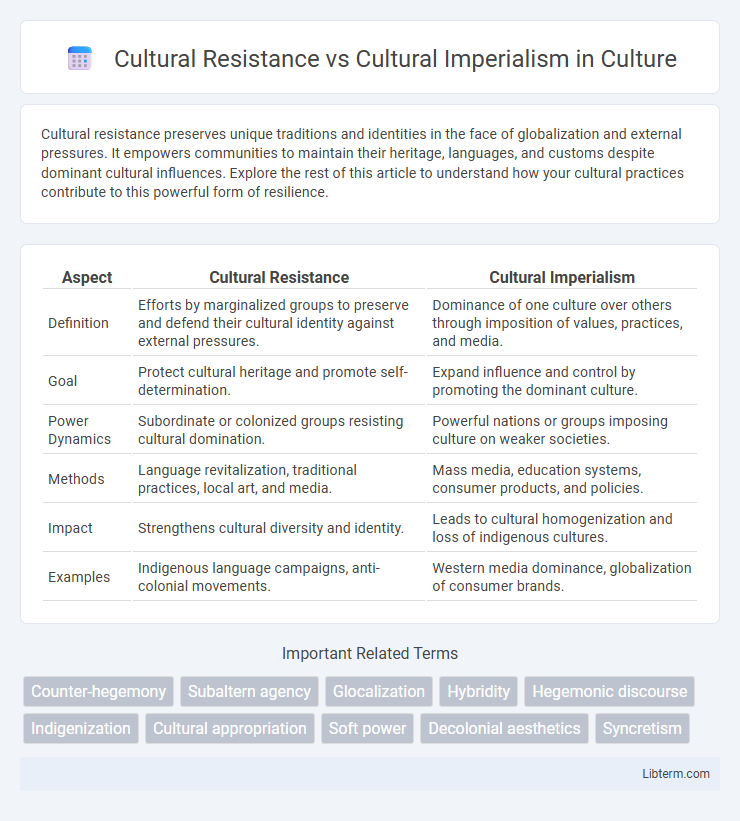Cultural resistance preserves unique traditions and identities in the face of globalization and external pressures. It empowers communities to maintain their heritage, languages, and customs despite dominant cultural influences. Explore the rest of this article to understand how your cultural practices contribute to this powerful form of resilience.
Table of Comparison
| Aspect | Cultural Resistance | Cultural Imperialism |
|---|---|---|
| Definition | Efforts by marginalized groups to preserve and defend their cultural identity against external pressures. | Dominance of one culture over others through imposition of values, practices, and media. |
| Goal | Protect cultural heritage and promote self-determination. | Expand influence and control by promoting the dominant culture. |
| Power Dynamics | Subordinate or colonized groups resisting cultural domination. | Powerful nations or groups imposing culture on weaker societies. |
| Methods | Language revitalization, traditional practices, local art, and media. | Mass media, education systems, consumer products, and policies. |
| Impact | Strengthens cultural diversity and identity. | Leads to cultural homogenization and loss of indigenous cultures. |
| Examples | Indigenous language campaigns, anti-colonial movements. | Western media dominance, globalization of consumer brands. |
Understanding Cultural Resistance
Cultural resistance embodies the efforts of marginalized groups to preserve their identity, language, and traditions in the face of dominant cultural influences and globalization pressures. It manifests through practices like indigenous art, local festivals, and community storytelling that counteract cultural homogenization imposed by cultural imperialism. Understanding cultural resistance highlights the power dynamics in cultural exchanges and the resilience of diverse cultures in maintaining autonomy and authenticity.
Defining Cultural Imperialism
Cultural imperialism refers to the dominance of one culture over others, often through media, language, and consumer goods, leading to the erosion of local traditions and identities. This concept highlights how powerful nations project their cultural values and practices globally, influencing social norms and economic behaviors in less dominant societies. It contrasts with cultural resistance, where communities actively preserve and promote their indigenous customs to counter homogenizing pressures.
Historical Roots of Cultural Imperialism
Cultural imperialism traces its roots to European colonial expansion in the 15th and 16th centuries, where dominant powers imposed their language, religion, and customs on colonized societies, fundamentally altering indigenous cultures. This historical process facilitated control not only through political and economic dominance but also by shaping cultural identities and social norms to align with imperial interests. In contrast, cultural resistance emerged as a response, involving the preservation and revitalization of native traditions, languages, and practices to combat cultural erosion and assert autonomy.
Manifestations of Cultural Resistance
Manifestations of cultural resistance include the preservation and revitalization of indigenous languages, traditional practices, and local art forms that challenge dominant cultural narratives. Community-led festivals, protests, and grassroots media platforms serve as powerful tools to assert identity against the homogenizing forces of cultural imperialism. These expressions provide a counter-narrative that empowers marginalized groups to reclaim agency and resist cultural assimilation imposed by global powers.
Media and the Spread of Cultural Imperialism
Media plays a pivotal role in the spread of cultural imperialism by disseminating dominant cultural narratives and values, often overshadowing local traditions and identities. Cultural resistance emerges as communities actively challenge and reinterpret media content to preserve and assert their unique cultural perspectives. This dynamic highlights the ongoing tension between hegemonic media influence and grassroots efforts to maintain cultural diversity and autonomy.
Local Identities in a Globalized World
Local identities often act as a powerful form of cultural resistance against the homogenizing effects of cultural imperialism in a globalized world. Communities preserve language, traditions, and customs as a means to assert autonomy and challenge dominant global narratives propagated by powerful media and economic forces. This dynamic reinforces the importance of cultural diversity and empowers marginalized groups to maintain their unique heritage amidst global interconnectedness.
The Role of Language in Cultural Conflict
Language acts as a primary vehicle for both cultural resistance and cultural imperialism, shaping identity and power dynamics within cultural conflicts. In cultural resistance, marginalized groups use native languages to preserve heritage and assert autonomy against dominant cultural forces. Conversely, cultural imperialism often involves imposing a foreign language to diminish local traditions and reinforce control over subject populations.
Power Dynamics Between Cultures
Cultural resistance challenges dominant power structures by preserving marginalized identities and traditions against the imposition of hegemonic cultural values. Cultural imperialism exerts control through the dissemination of dominant cultural norms, often leading to the erosion of indigenous practices and reinforcing global power imbalances. Power dynamics between cultures manifest in the struggle for cultural autonomy, where oppressed groups resist assimilation to maintain their unique social, political, and historical identities.
Case Studies of Cultural Resistance Movements
Cultural resistance movements such as the Zapatista uprising in Mexico and the Maori renaissance in New Zealand highlight local communities reclaiming autonomy against cultural imperialism imposed by dominant global forces. These movements emphasize the preservation of indigenous languages, traditions, and governance structures as tools to counteract cultural homogenization driven by Western media and economic influence. Case studies reveal how cultural resistance actively reshapes identities and fosters political empowerment in the face of globalization pressures.
Strategies for Preserving Cultural Diversity
Strategies for preserving cultural diversity amid cultural imperialism include promoting local languages, customs, and traditional art forms through educational curricula and community programs. Encouraging grassroots movements and indigenous media platforms empowers marginalized groups to assert their cultural identity and resist homogenization. Legal frameworks that protect cultural heritage sites and support cultural rights are critical for sustaining diverse cultural expressions in a globalized world.
Cultural Resistance Infographic

 libterm.com
libterm.com